 |
 |
 |
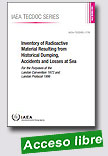 |
Inventory of Radioactive Material Resulting from Historical Dumping, Accidents and Losses at Sea (For the Purposes of the London Convention 1972 and London Protocol 1996)
IAEA TECDOC 1776, 2015, 48 p.
The Report of the United Nations Conference on Human Environment held in Stockholm in 1972 defined general principles for environmental protection. One of the principles specifically addressed the protection of the marine environment by the development of a set of “General Principles for Assessment and Control of Marine Pollution”. Pursuant to
|
Recommendation 86 of the Stockholm Conference, these principles for assessment and control of marine pollution were forwarded to an Inter-Governmental Conference held in London in 1972. This conference subsequently adopted the Convention on the Prevention of Marine Pollution by Dumping of Wastes and Other Matter (initially known as the London Dumping Convention but now as the London Convention). Currently 87 States are Contracting Parties to the London Convention. In 1996 a protocol was agreed for the purpose of modernizing the London Convention and eventually replacing it. The protocol is known as the London Protocol and currently has 45 State parties. The London Convention entered into force on 30 August 1975 and the London Protocol on 24 March 20061.
The Contracting Parties to the London Convention and Protocol agree to “promote the effective control of all sources of pollution of the marine environment, and pledge themselves especially to take all practicable steps to prevent the pollution of the sea by the dumping of wastes and other matter that is liable to create hazards to human health, to harm living resources and marine life, to damage amenities or to interfere with other legitimate uses of the sea”. Contracting Parties to the London Convention and Protocol designated the IAEA as the competent international authority in matters related to sea disposal of radioactive waste
and entrusted IAEA with specific responsibilities, as follows: to define high level radioactive wastes or other high level radioactive matter unsuitable for dumping at sea, as listed in Annex I to the Convention; to recommend a basis for issuing special permits for dumping other radioactive materials listed in Annex II to the Convention.
Extraído de: http://www-pub.iaea.org/books/IAEABooks/10925/Inventory-of-Radioactive-Material-Resulting-from-Historical-Dumping-Accidents-and-Losses-at-Sea-For-the-Purposes-of-the-London-Convention-1972-and-London-Protocol-1996 |
 |
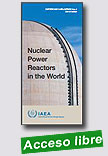 |
Nuclear Power Reactors in the World - 2016 Edition
IAEA Reference Data Series, 2016, 86 p.
This is the 36th edition of Reference Data Series No.2, which presents the most recent reactor data available to the IAEA. It contains summarized information as of the end of 2015 on power reactors operating, under construction and shut down as well as performance data on reactors operating in the IAEA Member States. The information is collected through designated national correspondents in the Member States and the data are used to maintain the IAEA's Power Reactor Information System (PRIS). |
Extraído de: http://www-pub.iaea.org/MTCD/Publications/PDF/RDS_2-36_web.pdf
|
 |
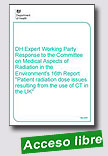 |
Working Party response to the COMARE 16 report: Patient radiation dose issues resulting from the use of CT in the UK
Department of Health (UK), 25 May 2016, 31 p.
This document sets out the responses to the 7 recommendations made in the Committee on Medical Aspects of Radiation in the Environment (COMARE) 16 report.
The COMARE 16 report advised the Department of Health about the increased radiation dose issues resulting from the use of diagnostic CT scans within the UK. The increased use of CT scans has raised concerns regarding the radiation dose
|
to patients. CT contributes more to the radiation exposure of patients, because it has greater doses of ionising radiation, compared with other imaging methods.
The Department of Health proposed that a working party of relevant experts consider the COMARE 16 report to offer practical advice for healthcare providers and make recommendations to the Department of Health.
Extraído de: https://www.gov.uk/government/publications/response-to-the-review-of-radiation-dose-issues-from-ct-scans
|
 |
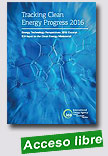 |
The annual Tracking Clean Energy Progress (TCEP) report highlights the development and deployment of key clean energy technologies year on year. An excerpt of the publication Energy Technology Perspectives (ETP), which lays out pathways towards a sustainable energy system in 2050, this comprehensive overview tracks the evolution of select technologies and sectors against the interim 2025 targets of the International Energy Agency (IEA) 2°C Scenario (2DS). |
Each assessment includes three sections: Recent trends discusses the latest progress with reference to technology development and penetration as well as market creation; Tracking progress includes a quantitative evaluation of progress towards meeting the 2DS; Recommended actions outlines measures to overcome barriers to meeting the 2DS.
TCEP 2016 features some good news: after record growth for the second year in a row, both solar photovoltaic and onshore wind are on track to meet the 2025 2DS targets; the number of electric vehicles passed the 1 million milestone in 2015; and the outlook for nuclear power improved, with the long-term 2DS targets more achievable than previously thought. However, most of the clean energy technologies examined are not on track. Therefore policy makers must build on the momentum from the Paris Agreement at COP21 and accelerate progress to make the technologies the new norm for energy systems.
TCEP 2016 – prepared for the Clean Energy Ministerial meeting where 23 member countries collaborate on solutions to advance clean energy globally – is an integral part of the specific recommendations to governments in ETP 2016 on how to scale up deployment of these key technologies to ensure a secure, clean and competitive energy future.
Extraído de http://www.iea.org/publications/freepublications/publication/tracking-clean-energy-progress-2016.html |
 |
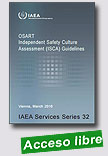 |
OSART Independent Safety Culture Assessment (ISCA) Guidelines
IAEA Services Series, 2016, 64 p.
The purpose of this guideline is to provide practical guidance on how to carry out an
Independent Safety Culture Assessment. The guideline is written from the perspective of an OSART independent safety culture assessment in order to highlight the benefits of this combination. The guideline can also be used as guidance whenever an independent safety culture assessment is |
performed as a standalone assessment or as add-on module for other types of safety review services.
The guide focuses on how to: Plan and conduct an OSART independent safety culture assessment; Analyse and communicate the results of the assessment.
It should be supplemented by training materials on safety culture assessment for OSART team members, including the safety culture assessors and peers in the facility targeted for the review.
This guideline can be integrated into other review and assessment processes. For example, regulatory authority oversight of licensees, safety assessments conducted by corporate bodies.
Apenas para revisão
Extraído de: http://www-pub.iaea.org/MTCD/Publications/PDF/SVS-32_web.pdf |
 |
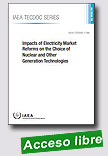
|
Impacts of Electricity Market Reforms on the Choice of Nuclear and Other Generation Technologies
IAEA-TECDOC, 2016, 154 p.
Electricity market reforms have been underway worldwide for the last 20 years. They have included restructuring, privatization, regulation and the introduction of market mechanisms in electricity generation and trading. This publication analyses the impacts of these reforms as well as non-reform factors, on the selection of electricity generation technologies, including nuclear power, by investors. A country |
case study approach has been adopted in developing the material presented in the publication. Each case study is organized around the following themes: rationale for reform; nature of the electricity market reform; how has the reform shaped the allocation of investment risk in electricity markets and how has this risk allocation influenced investor choice of generation technologies; and finally, how have non-reform related factors influenced investors’ choice. This report will be of use by stakeholders in the strategic planning of the electricity sector, including policy makers, policy analysts, policy advisors, power sector regulators and utility operators.
Extraído de:http://www-pub.iaea.org/books/IAEABooks/10927/Impacts-of-Electricity-Market-Reforms-on-the-Choice-of-Nuclear-and-Other-Generation-Techno
|
 |
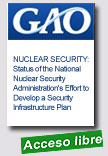 |
Nuclear Security: Status of the National Nuclear Security Administration's Effort to Develop a Security Infrastructure Plan
Government Accountability Office (GAO-US), May 13, 2016, 10 p.
The Senate Armed Services Committee report accompanying a bill for the National Defense Authorization Act for Fiscal Year 2015 included a provision for GAO to report on NNSA's effort to develop a Security Infrastructure Plan. This report examines (1) the status of NNSA's efforts to develop a statutorily required Security Infrastructure Plan and (2) the extent to which NNSA's .
|
future physical security infrastructure needs are included in the agency's current budget and planning documents. To examine the status of NNSA's efforts to develop a Security Infrastructure Plan and the extent to which it has included needed physical security infrastructure in its current budget and planning documents, GAO reviewed NNSA security planning and budget documents and interviewed NNSA and enterprise contractors.
Extraído de: http://www.gao.gov/products/GAO-16-447R?utm_medium=email&utm_source=govdelivery
|
 |
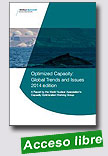 |
Optimized Capacity: Global Trends and Issues
World Nuclear Association, December 2015, 34 p.
This report draws upon data collected in the International Atomic Energy Agency’s (IAEA) Power Reactor Information Service database to present a snapshot of the performance of the world’s operating nuclear power reactors as well as a breakdown of the principal causes of capacity loss for the period 2010-2012.
While the idling of the Japanese fleet resulted in a decrease of the global average capacity factor to 72% in 2012 (down from |
77% in 2010) the global median capacity factor remains at about 84%. There is however a range of performance levels around that median with a long tail of reactors showing clear potential for improvement. Best performing units still regularly achieve greater than 90% – an industry benchmark. The potential for >90% capacity factors does not appear to be limited by reactor age and can be achieved by any of the major reactor types. This serves as testimony to the general robustness of existing nuclear technology and the commitment of the organizations involved.
The main findings of the report include: The vast majority of energy loss is within plant management control; Combined maintenance and refuelling outages are the single biggest cause of planned energy loss. Improving outage performance is key to achieving a high capacity factor; Best performing nuclear units manage to minimize scrams and achieve both productivity and safety; A strong safety record is a pre-requisite to a high capacity factor; An increasing number of plants have been put into long-term shutdown for regulatory reasons or because of component issues related to upgrades; Preventing similar occurrences is an industry-wide priority; Regardless of plant performance, policy and market forces have led to premature retirements in certain countries, and are putting other units under pressure. Action is needed to prevent the further loss of clean, reliable and low-cost nuclear energy in these places.
Extraído de: http://www.world-nuclear.org/our-association/publications/online-reports/optimized-capacity-global-trends-and-issues.aspx
|
 |
|
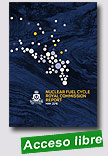
|
Nuclear Fuel Cycle Royal Commission Report, 2016
Nuclear Fuel Cycle Royal Commission, Government of South Australia, May 2016, 344 p.
South Australia can safely increase its participation in nuclear activities. Such participation brings social, environmental, safety and financial risks. The state is already managing some of these risks, and the remainder are manageable. Some new nuclear fuel cycle activities
are viable. One in particular, the disposal of international used fuel and intermediate level waste, could provide significant and |
enduring economic benefits to the South Australian community.
Viability analysis undertaken for the Commission determined that a waste disposal facility could generate more than $100 billion income in excess of expenditure (including a $32 billion reserve fund for facility closure and ongoing monitoring) over the 120-year life of the project (or $51 billion discounted at 4 per cent). Given the significance of the potential revenue and the extended project timeframes, the Commission has found that were such a project to proceed, it must be owned and controlled by the state government, and that the wealth generated should be preserved and equitably shared for current and future generations of South Australians. This presents an opportunity that should be pursued.
Social consent is fundamental to undertaking any new nuclear project. Social consent requires sufficient public support in South Australia to proceed with legislating, planning and
implementing a project. Local community consent is required to host a facility. In the event that this involves regional, remote and Aboriginal communities, consent processes must account for their particular values and concerns.
Political bipartisanship and stable government policy are also essential. This is particularly important given the long-term operation of facilities and the need for certainty for potential client nations.
Summary presentation
Extraído de: http://yoursay.sa.gov.au/system/NFCRC_Final_Report_Web.pdf
|
 |
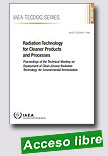 |
Radiation Technology for Cleaner Products and Processes
IAEA TECDOC, 2016, 246 p.
The technical meeting was aimed at presenting the recent development as well as revisiting global, regional, and national level initiatives for development and use of radiation technologies for developing environment friendly ‘Green’ processes and products. During this meeting, status of these initiatives was discussed and critically evaluated. The meeting focused on presenting new concepts and practical utilization of such techniques with an aim to evolve strategy for deployment
|
of these technologies and identify further needs of further scientific and technological development in this area. It provided a forum for sharing practical experiences in use of radiation technologies for treatment of environmental pollutants, lessons
learned and formulates the way ahead for integrating this technology with conventional technologies on a large scale. Finally, it targeted to strengthen contacts and fostering cooperation between technology providers, facility operators, administrators, coordinators of programmes in addressing environmental issues and the end-users.
Extraído de: http://www-pub.iaea.org/MTCD/Publications/PDF/TE-1786_web.pdf
|
 |
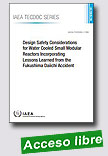 |
Design Safety Considerations for Water Cooled Small Modular Reactors Incorporating Lessons Learned from the Fukushima Daiichi Accident
IAEA TECDOC, 2016, 154 p.
The objectives of this publication is: To present technical lessons learned from sequence of events of the Fukushima Daiichi accident; To review the engineering designs and performance of the engineered safety features of water cooled small modular reactors in dealing with the design basis and severe accidents; To provide technical
|
considerations for appropriate and practical countermeasures to address the lessons learned from the Fukushima Daiichi accident to improve the design of engineered safety systems of small modular reactors; To provide indicative requirements for embarking countries planning to deploy small modular reactors and advanced cooled water reactors to prevent Fukushima Daiichi type accident; To provide technology developers and users with considerations to enhance the performance of the engineered safety feature of water cooled small modular reactors.
Extraído de: http://www-pub.iaea.org/MTCD/Publications/PDF/TE-1785_web.pdf
|
 |
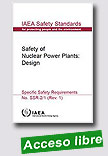 |
Safety of Nuclear Power Plants: Design
IAEA Safety Standards Series, 2016, 71 p.
This publication establishes requirements applicable to the design of nuclear power plants and elaborates on the safety objective, safety principles and concepts that provide the basis for deriving the safety requirements that must be met for the design of a nuclear power plant. It will be useful for organizations involved in design, manufacture, construction, modification, maintenance, operation and decommissioning of nuclear power plants, as well as for regulatory bodies. A review
|
of Safety Requirements publications was commenced in 2011 following the accident in the Fukushima Daiichi nuclear power plant in Japan. The review revealed no significant areas of weakness and resulted in just a small set of amendments to strengthen the requirements and facilitate their implementation, which are contained in the present publication.
Extraído de: http://www-pub.iaea.org/books/IAEABooks/10885/Safety-of-Nuclear-Power-Plants-Design
|
 |
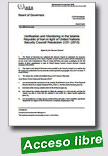 |
Verification and Monitoring in the Islamic Republic of Iran in light of United Nations Security Council Resolution 2231 (2015)IAEA, 16 January 2016, 5 p.
The Board of Governors has authorized the Director General to implement the necessary verification and monitoring of the Islamic Republic of Iran’s (Iran’s) nuclear-related commitments as set out in the Joint Comprehensive Plan of Action (JCPOA), and report accordingly, for the full duration of those commitments in light of United Nations Security Council (Security Council) resolution 2231 (2015).
|
This report to the Board of Governors and in parallel to the Security Council is to confirm that the Agency has verified that Iran has taken the actions specified in paragraphs 15.1–15.11 of Annex V of the JCPOA
Extraído de: https://www.iaea.org/sites/default/files/gov-inf-2016-1.pdf
|
 |
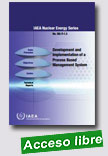 |
Development and Implementation of a Process Based Management System
IAEA Nuclear Energy Series, 2015, 57 p.
The implementation of a process based management system is challenging for many organizations accustomed to traditional, non-integrated, non-process based approaches to management systems. This publication provides practical guidance to nuclear organizations that are planning to implement a management system to comply with IAEA Safety Standards Series No.GS-R-3. It will also be beneficial for |
newcomer countries, since a vendor-provided “management system” delivered with a nuclear power plant to ensure safe operation is often a quality management system for operations and maintenance, which may integrate aspects related to safety and environmental protection. These quality assurance systems have to undergo a transition to a process based management system to ensure that the processes of the owner/operator will be tailored to achieve the goals and objectives for safe operation.
Extraído de: http://www-pub.iaea.org/books/IAEABooks/10709/Development-and-Implementation-of-a-Process-Based-Management-System
|
|
